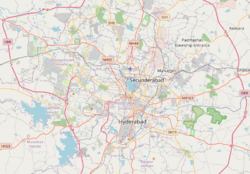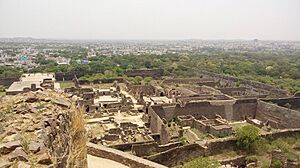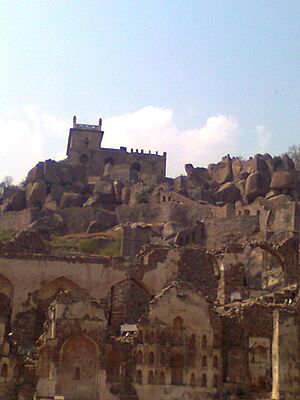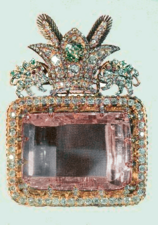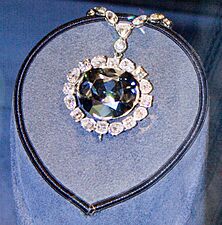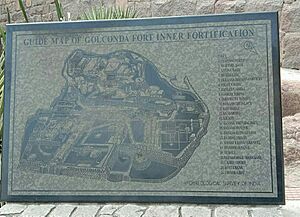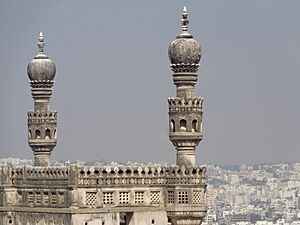Golconda facts for kids
Quick facts for kids Golconda |
|
|---|---|
| Hyderabad, India | |
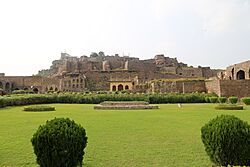 |
|
| Coordinates | 17°22′59″N 78°24′04″E / 17.38306°N 78.40111°E |
| Type | Fort |
| Site information | |
| Owner | Archaeological Survey of India |
| Controlled by | Archaeological Survey of India |
| Open to the public |
Yes |
| Site history | |
| Built | 11th century |
| Built by | Kakatiya_dynasty ruler King Prataparudra in the 11th century Sultan Quli Qutb-ul-Mulk (1518 fortification) |
| Garrison information | |
| Occupants | Bahmani Sultanate, Golconda Sultanate, Mughal Empire |
Golconda is an ancient fort and a ruined city near Hyderabad, Telangana, India. It was first built in the 11th century with mud walls by a ruler named Prataparudra from the Kakatiya dynasty. Later, it became a very important place for trading large diamonds, especially because of nearby mines like Kollur Mine. This led to famous gems known as Golconda Diamonds.
The fort is now abandoned and in ruins. In 2014, UNESCO added Golconda Fort to its "tentative list" to become a World Heritage Site. This means it might one day be recognized as a place of special importance to all of humanity.
Contents
Discovering Golconda's Past
The story of Golconda Fort began around the 11th century. It started as a small mud fort built by Prataparudra of the Kakatiya dynasty. The name "Golconda" likely comes from a Telugu phrase meaning "Cowherd's hill."
Over time, this small fort grew much larger. In 1518, Sultan Quli of the Qutb Shahi dynasty made it even stronger. He turned it into a huge, fortified city and made it the capital of the Golconda Sultanate.
How the Fort Grew Stronger
The Bahmani kings took control of the fort after the Kakatiyas. Under their rule, Golconda slowly became more important. Sultan Quli, who was a governor for the Bahmanids, made Golconda his main city around 1501.
As the Bahmani rule weakened, Sultan Quli became independent in 1518. He then started the Qutb Shahi dynasty with Golconda as its capital. Over 62 years, the first three Qutb Shahi sultans expanded the mud fort into the massive structure we see today. Its strong granite walls stretch for about 5 kilometers!
The Qutb Shahis ruled from Golconda until 1590. Then, they moved their capital to the new city of Hyderabad. The fort's outer wall, which was about 7 kilometers long, protected the entire city.
The Fall of Golconda
In 1687, the fort finally fell into ruin. This happened after a long eight-month siege by the Mughal emperor Aurangzeb. He captured the last Golconda king, Abul Hassan Tana Shah, ending the Qutb Shahi rule.
Golconda's Dazzling Diamonds
Golconda Fort was once a famous vault where some of the world's most well-known diamonds were kept. These included the legendary Koh-i-Noor and Hope diamonds.
Golconda became famous because of the diamond mines nearby, especially the Kollur Mine. In those days, India was the only place in the world with known diamond mines. Golconda was the main market where these precious gems were traded. The fort-city itself was a hub for the diamond business.
The name "Golconda" became so famous that it now means a place of great wealth. Some experts even use it to describe a very rare type of diamond called Type IIa. These diamonds are super clear and have almost no impurities. Many of these special diamonds came from the mines around Golconda.
Famous Diamonds from Golconda
Many incredible diamonds are believed to have come from the mines of Golconda. Here are some of them:
|
|
- Daria-i-Noor
- Noor-ul-Ain
- Koh-i-Noor
- Hope Diamond
- Princie Diamond
- Regent Diamond
- Wittelsbach-Graff Diamond
By the 1880s, people in English-speaking countries used "Golconda" to mean any very rich mine or source of great wealth. The diamonds brought huge riches to the Qutb Shahis and later to the Nizam of Hyderabad.
Exploring Golconda's Architecture
Golconda Fort is considered an important historical site by the Archaeological Survey of India. The fort is actually made up of four different forts. It has a long outer wall, about 10 kilometers long, with 87 rounded towers. Some of these towers still have cannons on them! There are also eight gateways and four drawbridges. Inside, you can find royal homes, halls, temples, mosques, and more.
The Clever Design of the Fort
The lowest part of the fort is the outer wall, which you enter through the "Fateh Darwaza" (Victory Gate). This gate is named after Aurangzeb's army, which marched through it. It has huge iron spikes to stop elephants from breaking it down.
One amazing feature is the fort's sound system. If you clap your hands at a certain spot under the dome at the entrance, the sound travels all the way to the 'Bala Hisar' pavilion. This is the highest point of the fort, almost a kilometer away! This clever design acted as an early warning system in case of an attack.
The Bala Hissar Gate is the main entrance on the eastern side. It has a pointed arch with beautiful designs. Above the door, you can see peacocks with fancy tails. The design of peacocks and lions shows the fort's Hindu beginnings.
Temples and Tombs
Inside the fort, you'll find the Jagadamba temple. Many people visit this temple, especially during the Bonalu festival. This temple is very old, dating back about 900 to 1,000 years to the early Kakatiya dynasty period. There's also a Mahankali temple nearby within the fort.
The fort also holds the tombs of the Qutub Shahi kings. These tombs are about 1 kilometer north of the fort's outer wall. They are built with beautiful Islamic architecture and are surrounded by lovely gardens. They are open to the public and are a popular place to visit in Hyderabad.
Other buildings inside the fort include the Habshi Kamans (Abyssinian arches), Taramati mosque, and the king's private chambers.
Golconda's Rulers
Many different powerful groups ruled Golconda throughout its history:
- Kakatiya dynasty
- Musunuri Nayakas
- Bahmani Sultans
- Qutb Shahi dynasty
- Mughal Empire
- Asaf Jahi dynasty
Naya Qila (New Fort)
Naya Qila is an extension of the Golconda fort. Sadly, parts of it were turned into the Hyderabad Golf Club. This happened despite people who owned the land and local groups protesting. The new fort has many towers and a very old, huge baobab tree, sometimes called the "Elephant-sized tree." It also has a war mosque. Because of the golf course, some of these areas are not easily accessible to the public.
Qutub Shahi Tombs
The tombs of the Qutub Shahi sultans are located about one kilometer north of Golconda's outer wall. These buildings are made of beautifully carved stone and are surrounded by lovely gardens. They are open to the public and are a popular place to visit in Hyderabad.
Golconda Artillery Centre
The Golconda Artillery Centre is a training center for the Indian Army. It was started on August 15, 1962, and is located in and around the Golconda fort. The center has three training groups and can train 2900 new recruits at a time.
UNESCO World Heritage Status
In 2010, India suggested that Golconda Fort and other Qutb Shahi monuments in Hyderabad, like the Charminar and the Qutb Shahi Tombs, should become World Heritage Sites by UNESCO. They are currently on India's "tentative list" for this special recognition.
Places Named After Golconda
The fame of Golconda spread far and wide, inspiring names in other parts of the world:
- A city in Illinois, United States.
- A city in Nevada, United States.
- A village in the southern part of Trinidad was named Golconda in the 19th century. It was once a rich sugar-cane farm.
Images for kids
-
Fort overlooking the city of Hyderabad
See also
- Afanasiy Nikitin – the first European to visit Golconda
- History of Hyderabad
- Naya Qila
- Taramati Baradari


